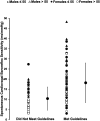Meeting international self-report muscle strengthening guidelines is associated with better cardiovagal baroreflex sensitivity in adults
- PMID: 39722741
- PMCID: PMC11668578
- DOI: 10.3389/fspor.2024.1509784
Meeting international self-report muscle strengthening guidelines is associated with better cardiovagal baroreflex sensitivity in adults
Abstract
Engaging in muscle strengthening activities (e.g., resistance training) at least twice/week is promoted by (Inter)national movement guidelines. Cardiovagal baroreflex sensitivity (cvBRS) reflects the ability to modulate R-R interval in response to changes in systolic blood pressure. Given the current conflicting literature, this study posed to explore the relationship between self-report muscle strengthening frequency and spontaneous cvBRS. 114 adults (62 females; age: 33 ± 19 years, 22% >55 years; body mass index: 24.2 ± 3.7 kg/m2) self-reported their weekly muscle strengthening activity frequencies via the Physical Activity and Sedentary Behaviour Questionnaire. Supine beat-by-beat R-R intervals [electrocardiography; 1.00 ± 0.18 s (0.90-1.50 s)] and systolic blood pressure [via finger photoplethysmography; 116 ± 11 mmHg (93-151 mmHg)] were recorded for 10.7 ± 2.0 min (5.3-14.5 min). Spontaneous cvBRS was assessed using the sequence technique. Data were analyzed using multiple regressions adjusted for age, sex, body mass index. Participants completed 2 ± 2 (0-7) days/week of muscle strengthening activities (56% met guidelines), and average overall cvBRS was 14.9 ± 9.1 (3.1-48.4) ms/mmHg. Higher reported frequencies were positively associated with overall cvBRS (Adjusted R2 = 0.40, p < 0.001; β = 2.24, p < 0.001). Meeting muscle strengthening activity guidelines was associated with improved overall cvBRS (Adjusted R2 = 0.29, p < 0.001; β = 7.68, p < 0.001). All results were unchanged if cvBRS for up-sequences or down-sequences only were used (all, p < 0.001). In conclusion, engaging in muscle strengthening exercises and particularly meeting existing guidelines were associated with better beat-by-beat vagally-mediated blood pressure regulation.
Keywords: autonomic function; blood pressure regulation; cardiovagal baroreceptor sensitivity; physical activity guidelines; resistance training.
© 2024 Waghorn, Schwartz, Shivgulam, Wu, Kimmerly and O’Brien.
Conflict of interest statement
The authors declare that the research was conducted in the absence of any commercial or financial relationships that could be construed as a potential conflict of interest. The author(s) declared that they were an editorial board member of Frontiers, at the time of submission. This had no impact on the peer review process and the final decision.
Figures


Similar articles
-
Meeting international aerobic physical activity guidelines is associated with enhanced cardiovagal baroreflex sensitivity in healthy older adults.Clin Auton Res. 2020 Apr;30(2):139-148. doi: 10.1007/s10286-019-00641-9. Epub 2019 Oct 12. Clin Auton Res. 2020. PMID: 31606797
-
Role of aortic arch vascular mechanics in cardiovagal baroreflex sensitivity.Am J Physiol Regul Integr Comp Physiol. 2016 Jul 1;311(1):R24-32. doi: 10.1152/ajpregu.00491.2015. Epub 2016 Apr 27. Am J Physiol Regul Integr Comp Physiol. 2016. PMID: 27122371
-
Evening binge alcohol disrupts cardiovagal tone and baroreflex function during polysomnographic sleep.Sleep. 2021 Nov 12;44(11):zsab130. doi: 10.1093/sleep/zsab130. Sleep. 2021. PMID: 34015116 Free PMC article. Clinical Trial.
-
Influence of an acute fast on ambulatory blood pressure and autonomic cardiovascular control.Am J Physiol Regul Integr Comp Physiol. 2022 Jun 1;322(6):R542-R550. doi: 10.1152/ajpregu.00283.2021. Epub 2022 Apr 5. Am J Physiol Regul Integr Comp Physiol. 2022. PMID: 35380473 Free PMC article. Clinical Trial.
-
Differential effect of head-up tilt on cardiovagal and sympathetic baroreflex sensitivity in humans.Exp Physiol. 2003 Nov;88(6):769-74. doi: 10.1113/eph8802632. Exp Physiol. 2003. PMID: 14603376 Clinical Trial.
References
-
- Lopez P, Taaffe DR, Galvão DA, Newton RU, Nonemacher ER, Wendt VM, et al. Resistance training effectiveness on body composition and body weight outcomes in individuals with overweight and obesity across the lifespan: a systematic review and meta-analysis. Obes Rev. (2022) 23(5):e13428. 10.1111/obr.13428 - DOI - PMC - PubMed
-
- Watson SL, Weeks BK, Weis LJ, Harding AT, Horan SA, Beck BR. High-intensity resistance and impact training improves bone mineral density and physical function in postmenopausal women with osteopenia and osteoporosis: the LIFTMOR randomized controlled trial. J Bone Miner Res. (2018) 33(2):211–20. 10.1002/jbmr.3284 - DOI - PubMed
-
- Park W, Jung WS, Hong K, Kim YY, Kim SW, Park HY. Effects of moderate combined resistance- and aerobic-exercise for 12 weeks on body composition, cardiometabolic risk factors, blood pressure, arterial stiffness, and physical functions, among obese older men: a pilot study. Int J Environ Res Public Health. (2020) 17(19):7233. 10.3390/ijerph17197233 - DOI - PMC - PubMed
LinkOut - more resources
Full Text Sources
Miscellaneous

